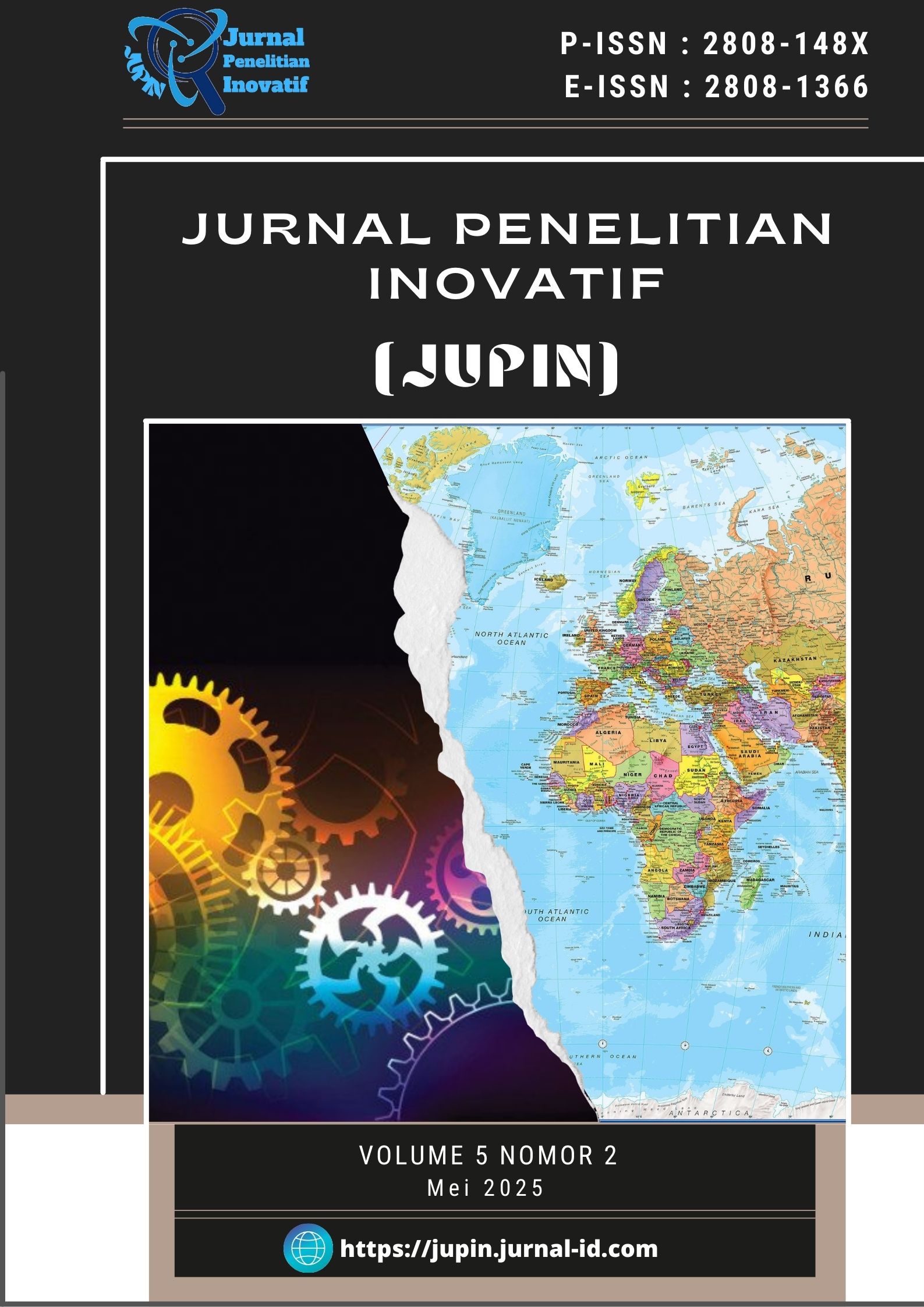Analisis Pengaruh Jumlah Rangkapan dan Pemberian Twist terhadap Sifat Mekanis Benang Kapas Murni: Analisis Menggunakan Anova
DOI:
https://doi.org/10.54082/jupin.1387Kata Kunci:
Benang Rangkap, Jumlah Rangkapan, Kekuatan Tarik, Mulur, TwistAbstrak
Benang merupakan salah satu komponen utama dalam industri tekstil yang menentukan sifat mekanis dan fungsional produk tekstil. Kekuatan tarik dan mulur benang dipengaruhi oleh berbagai faktor, termasuk jumlah rangkapan dan pemberian twist. Meskipun penggunaan benang rangkap telah banyak diterapkan dalam industri tekstil untuk meningkatkan kekuatan mekanis, masih diperlukan kajian lebih lanjut mengenai pengaruh jumlah rangkapan terhadap sifat fisik benang, khususnya kekuatan tarik dan mulur. Penelitian ini bertujuan untuk mengevaluasi pengaruh jumlah rangkapan dan twist terhadap sifat mekanis benang. Tahapan awal penelitian melibatkan pembuatan benang rangkap dengan variasi jumlah rangkapan (dua dan tiga) serta aplikasi twist pada benang menggunakan mesin doubling dan TFO. Pengujian kekuatan tarik dan mulur dilakukan menggunakan alat instron sesuai dengan standar SNI 7650:2010. Data hasil pengujian dianalisis menggunakan analisis varians (ANOVA) untuk menentukan signifikansi pengaruh jumlah rangkapan dan twist terhadap sifat mekanis benang. Hasil penelitian menunjukkan bahwa semakin tinggi jumlah rangkapan, semakin tinggi pula nilai kekuatan tarik dan mulur benang. Selain itu, benang yang diberikan twist memiliki kekuatan tarik yang lebih tinggi dibandingkan benang tanpa twist. Namun, peningkatan twist menyebabkan penurunan nilai mulur karena struktur benang menjadi lebih kaku. Dengan demikian, jumlah rangkapan dan tingkat twist menjadi parameter penting dalam optimasi desain benang untuk aplikasi industri tekstil.
Referensi
Afroz, F., & Islam, M. M. (2021). Study on mechanical property of woven fabrics made from 50/50 cotton-tencel blended siro yarn. Heliyon, 7(10).
Afroz, F., Rashid, M. M., Islam, M. M., & Akter, S. (2022). Investigation on the effect of cotton-tencel (50: 50) siro yarn twist multipliers on fabric stiffness. Heliyon, 8(12).
Ahmed, S. (2014). Prediction of yarn tenacity of raw cotton using fuzzy inference system. Bangladesh University of Engineering and Technology.
Babaarslan, O., Shahid, M. A., & Okyay, N. (2023). Investigation of the performance of cotton/polyester blend in different yarn structures. AUTEX Research Journal, 23(3), 370–380.
Chen, J., & Du, Z. (2020). Structural design and performance characterization of stable helical auxetic yarns based on the hollow-spindle covering system. Textile Research Journal, 90(3–4), 271–281.
Dejene, B. K., & Ayele, M. (2024). Impact of Weft Yarn Structure and Fiber Type on Weft Yarn Velocity and Twist Loss in Air-Jet Weaving: A Critical Review. Journal of Natural Fibers, 21(1).
Dolimov, A., Gafurov, A., Nasretdinov, A., & Akhmadjanov, A. (2023, June). Analysis of the twisting process with the addition of cotton yarn and water-soluble chemical yarn. AIP Conference Proceedings.
El-Sayed, E. R., & Abd-Elkawe, E. Y. (2021). Production of Fine Count Yarns from Some Extra-long Egyptian Cottons on Different Spinning Systems. European Journal of Agriculture and Food Sciences, 3(5), 90–96.
Erbil, Y., Babaarslan, O., Islam, M. R., & Sirlibas, S. (2022). Performance of core & dual-core cotton yarn structures on denim fabrics. Journal of Natural Fibers, 19(14), 9500–9513.
Hassan, S. H., Hussain, T., Awais, H., & Ali, Z. (2024). Effects of yarn count and twist multiplier on the properties of knitted fabrics made from naturally colored sustainable cotton. Journal of Engineered Fibers and Fabrics, 19.
Kulkarni, K. M., & Sahu, A. R. (2022). Brief overview on study of various parameters affecting the productivity of cotton yarn. Smart Technologies for Energy, Environment and Sustainable Development, Vol 1. Springer Proceedings in Energy.
Olgun, Y., Babaarslan, O., & Habib, A. (2025). Development of dual-core spun yarn using different fiber as a core by hamel twisting (elasto twist) technique and its impact on the denim fabric performance. The Journal of The Textile Institute, 116(4), 680–690.
Oner, E., Topcuoglu, S., & Kutlu, O. (2018). The effect of cotton fibre characteristic on yarn properties. IOP Conference Series: Materials Science and Engineering , 012057.
Parpiev, K., Parpiev, D., Soloxiddinov, J., Toirov, U. B., & Rizaev, B. (2023). The difference between the length of single yarns in plied yarn content in different twisting machines. AIP Conference Proceedings.
Patil, K. R., Sing, K., Kolte, P. P., & Daberao, A. M. (2017). Effect of twist on yarn properties. International Journal on Textile Engineering and Processes, 3(1), 19–23.
Purnomo, A. (2024). Pemetaan Rantai Pasokan Di Industri Tekstil Dan Produk Tekstil. Arta Media.
Safari Gorjan, E., Ezazshahabi, N., & Mousazadegan, F. (2021). Study on the tearing behaviour of woven shirting fabrics–the effect of yarn and fabric properties. International Journal of Clothing Science and Technology, 33(3), 353–363.
Sekerden, F. (2011). Investigation on the unevenness, tenacity and elongation properties of bamboo/cotton blended yarns. Wetlands, 6(9).
Shah, D. U., Schubel, P. J., & Clifford, M. J. (2012). Modelling the effect of yarn twist on the tensile strength of unidirectional plant fibre yarn composites. Journal of Composite Materials, 47(4), 425–436.
Sowmya, R., Vasugi Raaja, N., & Prakash, C. (2017). Investigation of relationship between blend ratio and yarn twist on yarn properties of bamboo, cotton, polyester, and its blends. Journal of Natural Fibers, 14(2), 228–238.
Vysanska, M. (2024). Counter-plying of two-ply yarn: inner structure changes and external response. Textile Research Journal, 94(19), 2220–2231.
Wang, Y., Cao, G., Xia, L., Sheng, D., Jiang, S., Pan, H., ..., & Xu, W. (2017). Effect of anti-creasing component on properties of two-ply cotton yarn. Cellulose, 24, 3073–3082.
Zhou, X., Fang, S., Leng, X., Liu, Z., & Baughman, R. H. (2021). The power of fiber twist. Accounts of Chemical Research, 54(11), 2624–2636..
Unduhan
Diterbitkan
Cara Mengutip
Terbitan
Bagian
Lisensi
Hak Cipta (c) 2025 Fahmi Fawzy Rusman, Nurfadilah Ikhsani, Andrian Wijayono, Verawati Nurazizah, Reski Alya Pradifta, Wilda Murti

Artikel ini berlisensi Creative Commons Attribution 4.0 International License.


















